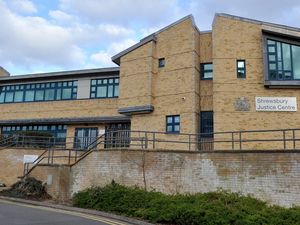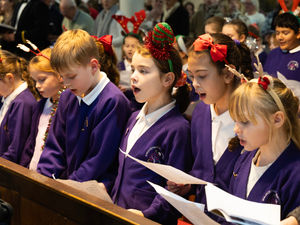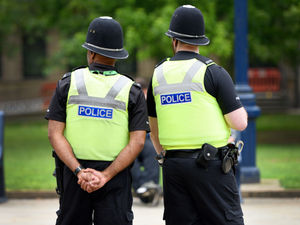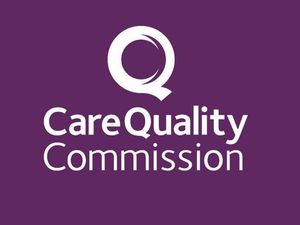Learning lessons of the Holocaust
Shropshire sixth-form students have been to Poland to see the former Nazi death camp at Auschwitz, where more than 1 million people were murdered. The Shropshire Star's Andrew Owen went with them.
Shropshire sixth-form students have been to Poland to see the former Nazi death camp at Auschwitz, where more than 1 million people were murdered. The Shropshire Star's Andrew Owen went with them.
Behind the glass wall of a display cabinet in Auschwitz 1 there is a suitcase.
It is one of hundreds, possibly thousands. It is brown, and battered, and it has a name painted on it: Hahn, Irene.
There is a date, too: 1929.
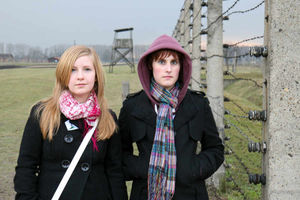
Irene Hahn would have been 80 this year; a grandmother, probably, or even a great-grandmother.
But Irene Hahn was Jewish – and in this place her future was taken away.
Did she survive for long, I wonder, as a prisoner being worked to death in the most appalling conditions, or was she - like three quarters of those brought here in cattle trucks from across Europe - sent straight to the gas chambers?
I wonder if her hair is among the greying pile behind the glass of another cabinet. Are her shoes among the 40,000 on display? Her clothes? Her glasses? Is that her hairbrush? Did she have a family? Could those baby clothes be her brother's?
Did that tin contain the gas pellets they used?
And this is just a glimpse of the history of Auschwitz, a fraction of the possessions stolen from thousands of arrivals each day; possessions sorted and sent back to Germany to aid the war effort; possessions sorted and packed while their owners were being gassed and their bodies taken to the ovens.
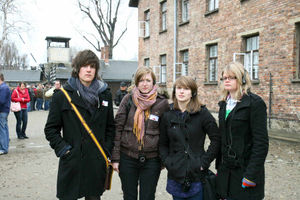
"There was this one little white shoe, a child's shoe, and I started crying."
Ellie was one of a group of Shropshire sixth-formers who joined more than 200 students from across the West Midlands for the one-day visit, part of the Holocaust Educational Trust's Lessons from Auschwitz project.
The trust, which is sponsored by a Government grant, sends two students from every post-16 college in England to visit Oswiecim, where Auschwitz was created, the Auschwitz 1 concentration camp, and the death camp Auschwitz-Birkenau.
On their return, they will tell classmates about what they have seen, passing on the lessons of the Holocaust.
Our visit, on a cold and grey March day, began in Oswiecim's Jewish cemetery, where those who died before the Holocaust are buried.
But, our guide tells us, these gravestones tell a story because it is impossible to say who lies beneath them.
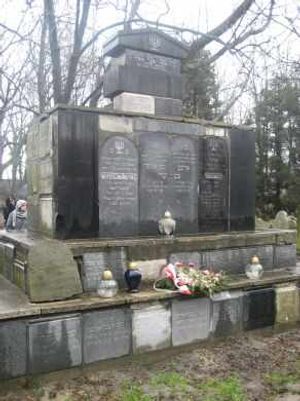
Before the war Oswiecim was 58 per cent Jewish.
Today, it has no Jewish population.
And to highlight the importance of today's visit, he tells us that even recently the cemetery has seen anti-Semitic vandalism.
From the cemetery we are driven the short distance to Auschwitz 1.
It takes you by surprise, this place. It stands on the edge of the town, with fields nearby and a main road outside.
I had expected somewhere isolated, where the crimes would have been committed in secrecy.
And I was not prepared for how busy it was. Touristy. At the entrance there were hundreds of students from all over Europe sitting on the steps or in the corridor eating lunch.
Once inside, however, at the main gate with its breathtakingly cynical "Arbeit Macht Frei" sign (Work makes you free), the atmosphere becomes more sombre.
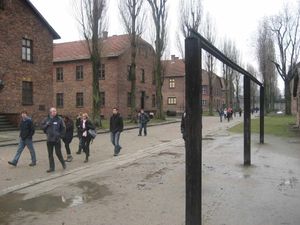
It's what's in them that shocks, the evidence of the crimes committed, the pictures and the remains of the ordinary lives that were ended here, behind the barbed wire.
And we walk through the gas chamber and see the ovens – a stone's throw from where the camp commandant lived with his wife and young family.
And then we are driven the Aushwitz-Birkenau, the death camp.
You've seen it in hundreds of films and documentaries, but nothing prepares you for actually walking through its gates.
Here is the railway line on which the cattle trucks arrived. Here is the site where the selections were carried out, here is the route up to 20,000 people took to the gas chambers each day.
And here is where those who survived the selections were taken, where they were stripped, tattooed with a prison number and the cramped wooden barracks where they were housed.
And here are the remains of the gas chambers, destroyed when the Nazis tried to cover-up their crimes.
"I didn't realise how big Auschwitz was," said Tim Bierley, who attends Shrewsbury Sixth Form College.
"It begins to hit home. You come here and it's just numbers, but once you're here it puts it into some form of context."
Tim said he had wanted to see Auschwitz for himself. He hoped to visit schools back home to tell children about the Holocaust.
Ellie Staite said Birkenau had seemed "so quiet, and so big, and you could kind of feel what had happened. It felt kind of oppressive, and I still find it quite hard to take in, but I'm glad I went.
"It actually happened, and for people to deny it, for people think it didn't happen or not to learn about it, I think is awful."
Rachel Redman, who also attends the Girls' High School, said: "You hear about how many people died and you can't take it in. Once you're there it's almost even harder to take it in because you're seeing it, and it's there right in front of you, but you still can't comprehend that people would do that."
At the end of our visit we gather on the site of the gas chambers, where a memorial was built in 1967, and we reflect on our visit and what we have seen.
Rabbi Barry Marcus, from the Synagogue of Central London, reads a Hazkara, a memorial prayer for the victims, and we light candles in their memory as the sun goes down.
And I think of Irene Hahn.
And I hope that no-one else will ever go through what she did.
Holocaust Educational Trust - the facts
Visits are run by the Holocaust Educational Trusts Lessons from Auschwitz Project
The trust was set up in 1988 with the aim of increasing knowledge of the Holocaust and the dangers of racism
So far, it has taken more than 5,000 students and teachers to Auschwitz-Birkenau
Thanks to a £1.5m Treasury grant, the project will eventually take two sixth-form students from every school and college in the UK to Auschwitz-Birkenau
Facts about the Holocaust
There were six Nazi extermination camps, all built in Poland.
Auschwitz was established in 1940 as a concentration camp on the site of a former polish army barracks.
It was originally for political and anti-social elements
Auschwitz was developed into three camps: Auschwitz 1, the concentration camp; Auschwitz-Birkenau, the death camp, and Auschwitz III, the labour camp. There were 40 sub-camps.
According to estimates, 1.3 million people were sent to Auschwitz. 1.1million of them died there, 1 million of whom were Jewish
It is thought that six million people were murdered in the Holocaust.

